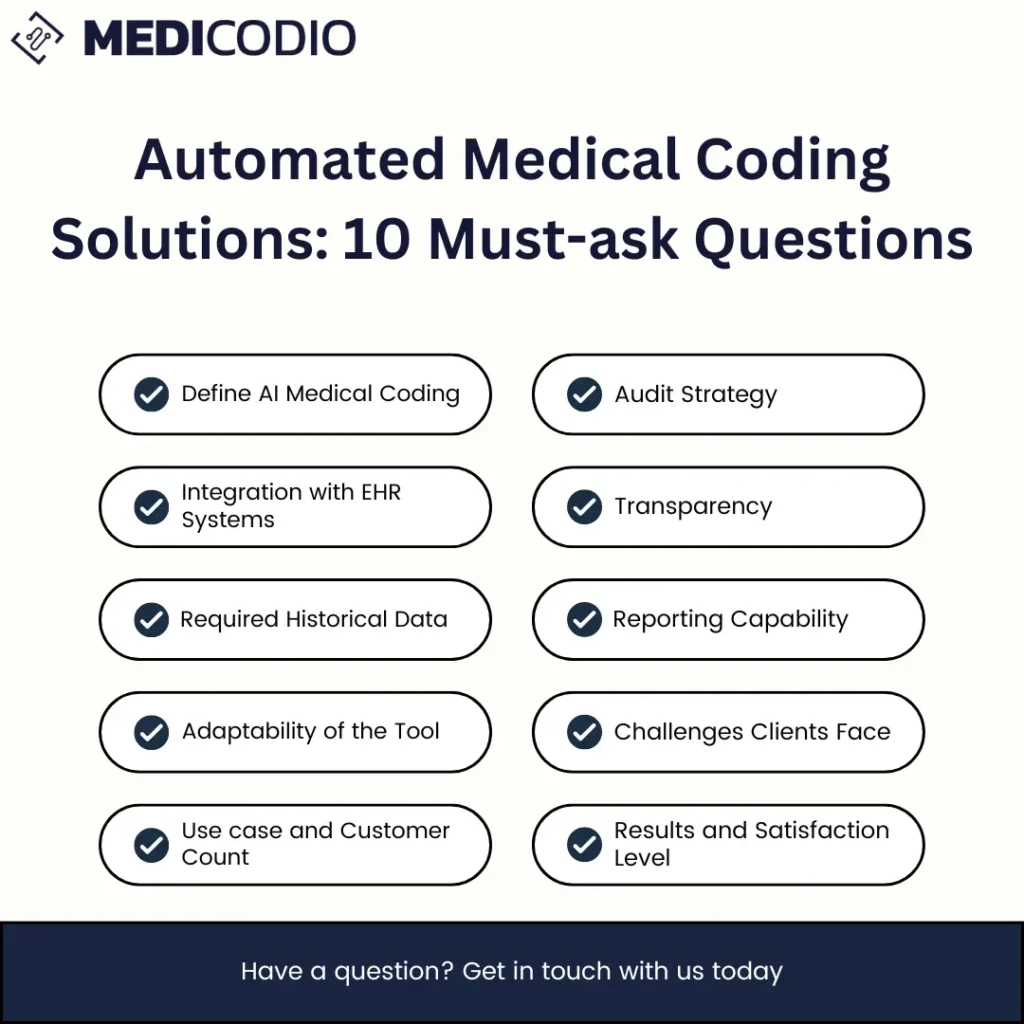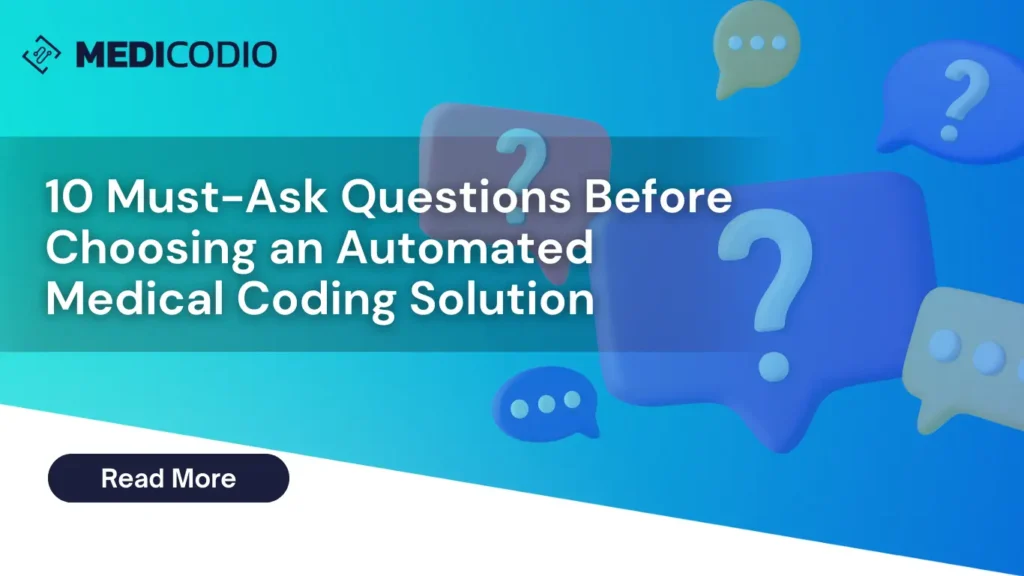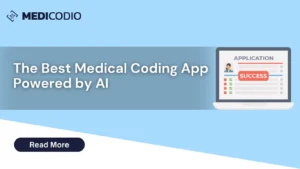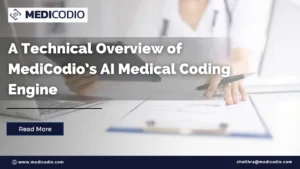Question what you hear, and see for yourself, A healthy doubt keeps you safe and well. This adage holds perfectly true when selecting AI-based software products.
Do you want to listen to MediCodio’s answers to the 10 questions? Contact us today!
When considering AI solutions for medical coding, it’s essential to question the claims and capabilities presented by vendors or developers. This involves asking probing questions about how the AI system works, its accuracy rates, the data it’s trained on, and its ability to adapt to different coding scenarios. By questioning and seeking evidence for the software’s capabilities, you ensure that you’re making an informed decision and not relying solely on marketing or hearsay.
Moreover, maintaining a healthy doubt means being aware of potential pitfalls or limitations of AI systems in medical coding. While AI can offer significant benefits such as increased efficiency and accuracy, it’s better to check for the product’s potential to fulfill your needs.
1. How do you define automated medical coding solutions with AI?
Automated medical coding solutions with AI involve the use of artificial intelligence (AI) technologies to streamline and enhance the process of assigning medical codes to patient records. These solutions leverage machine learning algorithms, natural language processing (NLP), and other AI techniques to interpret clinical documentation, extract relevant information, and generate accurate medical codes.
At MediCodio, we use advanced technologies such as OCR, RPA, API, ML, and NLP to streamline the medical coding process.
Here’s a breakdown of how automated medical coding solutions with AI work:
-
- Data Processing: The system ingests electronic health records (EHRs), physician notes, lab reports, and other medical documents containing patient information.
-
- Natural Language Processing (NLP): NLP algorithms analyze the text within these documents to identify key terms, diagnoses, procedures, medications, and other relevant clinical data.
-
- Clinical Coding Rules: The AI system applies clinical coding rules and guidelines (such as ICD-10, CPT, or HCPCS) to the extracted information to generate appropriate medical codes.
-
- Machine Learning (ML): Machine learning models are trained on vast datasets of labeled medical records to improve accuracy and coding consistency over time. These models learn patterns and correlations to enhance coding efficiency.
-
- Validation and Review: The automated coding process includes validation steps to ensure accuracy and compliance with coding standards. Human reviewers may also be involved in quality assurance checks.
-
- Integration with Healthcare Systems: The coded data is integrated back into the healthcare organization’s systems, such as billing software or electronic medical records, to facilitate claims processing, reimbursement, and data analytics.
Benefits of automated medical coding solutions with AI include:
-
- Efficiency: Faster coding processes reduce manual effort and administrative burden.
-
- Accuracy: AI algorithms can improve coding accuracy by reducing human errors and inconsistencies.
-
- Compliance: Adherence to coding standards and regulatory requirements is enhanced.
-
- Cost Savings: Reduced labor costs and improved revenue cycle management contribute to financial benefits.
-
- Data Insights: Coded data can be analyzed for trends, insights into patient populations, and healthcare outcomes.
Overall, automated medical coding solutions with AI are crucial in optimizing healthcare operations, improving coding accuracy, and supporting better patient care.
2. How does the automated medical coding solution integrate with existing electronic health record (EHR) systems?
If an AI-medical coding tool fails to integrate properly with EHR systems, several challenges arise. Firstly, without seamless integration, data transfer between the AI tool and EHRs becomes cumbersome and error-prone. This can lead to incomplete or inaccurate information being processed, compromising the coding accuracy and overall efficiency of the system.
Secondly, inadequate integration may result in delays or disruptions in the coding workflow, impacting the timely submission of claims and reimbursement processes. Thirdly, without synchronized access to updated patient records, the AI tool may struggle to adapt to changes in clinical documentation practices or coding guidelines, affecting coding consistency and compliance.
Therefore, inquiring about EHR integration is crucial. It ensures that the AI system can access up-to-date patient information, including diagnoses, procedures, medications, and treatment plans, directly from the EHR. This access is vital for accurate coding and compliance with coding standards and regulations. Also, proper integration enables real-time data synchronization, minimizing errors, and delays in coding processes. This synchronization facilitates efficient claims processing, billing accuracy, and timely reimbursement, enhancing revenue cycle management.
Furthermore, inquiring about EHR integration allows providers and RCM companies to assess the compatibility and interoperability of the AI tool with their existing IT infrastructure. It helps identify potential technical challenges or compatibility issues early in the implementation process, allowing for timely resolutions and smoother deployment of the AI coding solution. Additionally, understanding the extent of EHR integration helps stakeholders plan for training, workflow adjustments, and optimization of coding processes to fully leverage the benefits of AI in medical coding.
3. How much historical data do you require to set up your automated medical coding solution and how is that data used?
To set up an automated medical coding solution effectively, the amount of historical data required can vary depending on the complexity of the AI algorithms and the specific requirements of the healthcare organization. Generally, a substantial volume of historical data is essential to train machine learning models adequately and ensure accurate coding outcomes. The historical data used in automated medical coding solutions encompasses a wide range of patient records, clinical documentation, coding histories, and relevant healthcare information.
The utilization of historical data in automated medical coding solutions is multi-faceted and plays a crucial role in the development, training, and optimization of AI algorithms. Here is an in-depth exploration of how historical data is utilized in the setup and functioning of automated medical coding solutions:
Training Machine Learning Models: Historical data serves as the foundation for training machine learning models that power automated medical coding solutions. These models analyze patterns, correlations, and relationships within the data to learn how to accurately interpret clinical documentation and assign appropriate medical codes. The more diverse and representative the historical data, the better the models can generalize and adapt to new coding scenarios.
Algorithm Development and Refinement: Historical data is used to develop and refine the algorithms that drive automated medical coding solutions. Data scientists and AI experts analyze historical data to identify key features, coding patterns, and coding nuances specific to healthcare domains. This analysis informs the design of algorithms that can handle complex medical terminology, variations in documentation styles, and evolving coding standards.
Validation and Testing: Historical data is crucial for validating and testing the accuracy and performance of automated medical coding solutions. The AI algorithms are tested against historical records with known coding outcomes to assess their ability to generate correct codes and identify any discrepancies or errors. This validation process helps fine-tune the algorithms and improve coding accuracy before deployment in live healthcare environments.
Continuous Learning and Improvement: Once deployed, automated medical coding solutions continue to leverage historical data for continuous learning and improvement. The algorithms analyze coded data over time, comparing it with historical coding trends and outcomes to identify areas for refinement or optimization. This iterative process of learning from historical data enhances the accuracy, efficiency, and adaptability of the AI coding solution.
Compliance and Quality Assurance: Historical data is also used for compliance purposes and quality assurance in automated medical coding. The algorithms are trained to adhere to coding standards, regulatory requirements, and best practices based on historical coding patterns and guidelines. This ensures that the automated coding process maintains accuracy, consistency, and compliance with industry standards.
In summary, historical data plays a pivotal role in every stage of setting up and operating automated medical coding solutions. From training machine learning models to validating algorithms, optimizing performance, and ensuring compliance, the utilization of historical data is fundamental to the success and effectiveness of AI-driven coding solutions in healthcare.
4. How adaptable is the automated medical coding solution to updates in coding guidelines, regulations, and changes in medical terminology?
The adaptability of an automated medical coding solution to updates in coding guidelines, regulations, and changes in medical terminology is a crucial aspect that healthcare providers must inquire about when evaluating such solutions. This question is a must-ask because of several key reasons.
Firstly, the healthcare industry is dynamic, with frequent updates in coding guidelines, regulations, and medical terminology. These changes directly impact the accuracy and compliance of medical coding processes. An automated coding solution must be capable of seamlessly incorporating these updates to ensure that the codes assigned to medical procedures and diagnoses remain accurate and compliant with current standards.
Secondly, regulatory compliance is paramount in healthcare. Coding errors or non-compliance can lead to financial penalties, denied claims, and reputational damage. Providers need assurance that the automated coding solution can swiftly adapt to regulatory changes to avoid such risks and maintain smooth revenue cycle management.
Moreover, medical terminology is constantly evolving, with new terms, abbreviations, and clinical concepts emerging regularly. The ability of the coding solution to understand and integrate these changes ensures that it can accurately interpret medical documentation and assign the correct codes, ultimately improving coding efficiency and reducing errors.
Additionally, healthcare providers often work with multiple payers, each having their coding guidelines and reimbursement rules. An adaptable coding solution can accommodate these variations, ensuring consistent and accurate coding across different payer requirements.
Furthermore, technological advancements and industry innovations may introduce new procedures or treatments that require coding. An adaptable coding solution can quickly incorporate these new codes and ensure that providers can accurately capture and bill for these services.
Overall, the adaptability of an automated medical coding solution to updates in coding guidelines, regulations, and changes in medical terminology is critical for ensuring compliance, accuracy, efficiency, and seamless revenue cycle management for healthcare providers. Asking about this adaptability ensures that providers invest in a solution that can evolve with the dynamic healthcare landscape and deliver long-term value.
5. What’s the strategy you use to monitor and audit the automated medical coding solution to ensure accuracy?
There are several reasons why a healthcare provider must ask about the auditing strategy for an AI medical coding tool. Here’s why:
-
- Maintaining Accuracy is Paramount: Medical coding accuracy directly impacts reimbursement. Even minor errors can lead to denied claims, delayed payments, and lost revenue. An effective auditing strategy ensures the AI tool is consistently learning and adapting to maintain high coding accuracy.
-
- Compliance with Regulations: Healthcare providers must comply with strict coding regulations set by payers and government agencies. The auditing process verifies the AI tool adheres to these regulations, minimizing the risk of audits and potential penalties.
-
- Building Trust in the System: Transitioning to AI-powered coding requires trust. A transparent auditing strategy allows healthcare providers to monitor the tool’s performance and identify areas for improvement. This fosters confidence in the system’s ability to deliver reliable results.
-
- Identifying Biases and Errors: AI algorithms, like any system, can be susceptible to biases. Auditing helps unearth potential biases in the coding process, ensuring fair and accurate representation of patient encounters. Additionally, it helps catch any errors the AI might make, allowing for corrective measures.
-
- Continuous Improvement: The healthcare landscape constantly evolves, with new codes and regulations emerging. A robust auditing strategy allows providers to assess how well the AI tool adapts to these changes. This ensures the system stays up-to-date and delivers optimal performance over time.
By asking about the auditing strategy, healthcare providers can gain valuable insight into the AI tool’s reliability and ensure it aligns with their commitment to accurate coding, regulatory compliance, and patient care.

6. How much transparency does the automated medical coding solution provide? Can it explain why specific codes were assigned?
One of the biggest challenges with AI, especially in healthcare, is the lack of transparency. In medical coding, accurate billing relies on assigning the correct codes based on the patient’s condition and procedures. A “black box” AI system that simply outputs codes without explanation makes it difficult for humans to understand the reasoning behind the decision. This can lead to several problems:
-
- Errors and Missed Codes: If you don’t understand why a code was assigned, there’s a chance it could be wrong. This could lead to underbilling or overbilling, both of which are problematic.
-
- Compliance Issues: Regulatory bodies often require auditors to be able to verify the accuracy of coding decisions. Without transparency, this becomes difficult.
-
- Lack of Trust: Clinicians and coders need to trust the AI system to make accurate decisions. Without understanding how it works, trust is difficult to establish.
By asking about transparency, you’re pushing the vendor to explain how their system works and how it arrives at its coding decisions. An ideal response will detail features that provide explainability, such as:
-
- Reasoning Reports: The system should be able to generate reports that explain why specific codes were assigned. This could involve highlighting relevant keywords in the medical record, referencing coding guidelines, or providing similar past cases.
-
- User Interface: The user interface should allow coders to easily see the rationale behind the suggested codes. This might involve highlighting relevant sections of the record or offering different coding options with explanations for each.
-
- Human-in-the-Loop Workflow: The best AI coding systems don’t replace human coders entirely. Instead, they should assist coders by suggesting codes and providing explanations. The final decision should always rest with a qualified human coder who can leverage the AI’s insights but also apply their own expertise.
Benefits of Transparency
Transparency in AI medical coding offers several benefits:
-
- Improved Accuracy: By understanding how the AI arrives at its conclusions, coders can identify and correct errors, leading to more accurate coding.
-
- Enhanced Compliance: Explainable AI systems make it easier to demonstrate compliance with coding regulations.
-
- Increased Trust: When coders and clinicians understand the AI’s reasoning, they are more likely to trust its suggestions and recommendations.
-
- Better decision-making: Transparency allows coders to learn from the AI and improve their own coding skills.
In conclusion, your question is brilliant because it goes beyond simply asking if the system works. It pushes the vendor to explain how it works and how it can benefit your specific needs. This is crucial for ensuring that the AI coding system is not just efficient but also trustworthy and reliable.
7. What kind of reporting, if any, does the AI-based automated medical coding solution provide?
AI-based automated medical coding solutions typically provide comprehensive reporting capabilities that are crucial for healthcare providers. These reports can include detailed insights into coding accuracy, trends in coding patterns, coding efficiency metrics, compliance adherence, and financial performance related to coding.
For example, providers can receive reports on coding errors or discrepancies, coding turnaround times, and comparisons between automated and manual coding processes. These reports not only help in monitoring the performance of the AI solution but also enable providers to make data-driven decisions to optimize coding processes, improve revenue cycle management, and ensure compliance with regulatory requirements.
Asking about the type of reporting provided by AI-based automated medical coding solutions is a must for healthcare providers for several reasons. First, it allows providers to evaluate the effectiveness and ROI of the AI solution. Understanding the specific metrics and insights provided in reports helps providers assess how well the solution aligns with their organizational goals and objectives. Second, reporting plays a crucial role in quality assurance and compliance. Providers can use reports to identify coding errors, audit coding practices, and ensure accurate documentation, which is essential for proper reimbursement and regulatory compliance.
Third, reporting facilitates continuous improvement and optimization of coding processes. By analyzing trends and performance metrics from reports, providers can implement corrective measures, refine coding workflows, and enhance overall efficiency in revenue cycle management.
In addition to operational benefits, robust reporting from AI-based automated medical coding solutions enhances transparency and accountability within healthcare organizations. Clear and detailed reports enable effective communication between coding teams, clinicians, and revenue cycle management staff. They provide a shared understanding of coding performance, challenges, and opportunities for improvement, fostering collaboration and alignment across departments. Ultimately, asking about reporting capabilities helps healthcare providers leverage AI solutions not just for automation but also for strategic decision-making, compliance assurance, and continuous performance improvement in medical coding processes.
8. How many health systems, hospitals, and/or physician groups are actively using your automated medical coding solution to code charts?
Knowing how many health systems, hospitals, and physician groups are actively using an automated medical coding solution is a must-ask question for healthcare providers for several critical reasons. Firstly, understanding the user base gives insight into the solution’s adoption rate and popularity within the healthcare industry. It reflects the solution’s credibility, effectiveness, and ability to meet the needs of diverse healthcare organizations. Providers can gauge the solution’s track record, reliability, and potential benefits by knowing how widely it is already being used.
Secondly, the number of active users can indicate the solution’s scalability and capacity to handle large volumes of coding tasks. Healthcare providers often deal with a considerable volume of medical records that require accurate and efficient coding. Knowing that other health systems, hospitals, and physician groups are successfully using the automated coding solution implies that it can handle the workload effectively, ensuring timely and accurate coding processes.
Lastly, understanding the user base helps healthcare providers assess the solution’s compatibility with their systems and workflows. It prompts questions about integration capabilities, support services, and user feedback. Providers can learn from others’ experiences with the solution, identify potential challenges or advantages, and make informed decisions about its suitability for their organization. In essence, knowing the extent of the adoption of an automated medical coding solution provides valuable insights into its performance, scalability, and compatibility with the provider’s needs.
9. What challenges have clients run into using the automated medical coding solution?
Asking about the challenges clients have encountered using automated medical coding solutions is crucial for healthcare providers for several reasons. Firstly, understanding these challenges helps providers anticipate potential issues they may face during implementation. This foresight allows them to proactively address these challenges, reducing the risk of disruptions to their operations and ensuring a smoother transition to the new system.
Secondly, learning about the challenges clients have experienced provides valuable insights into the limitations or areas for improvement in the automated coding solution. This information empowers providers to engage in meaningful discussions with vendors, seeking clarification on how these challenges are being addressed or mitigated in newer versions or updates of the solution. It also helps in setting realistic expectations regarding the capabilities and performance of the AI system.
Lastly, knowing the challenges clients have run into enables healthcare providers to learn from others’ experiences and adopt best practices. They can leverage this knowledge to develop strategies for successful implementation, optimize workflows, and train staff effectively. By asking about these challenges, providers demonstrate a commitment to understanding the nuances of automated medical coding solutions and ensuring their successful integration into their healthcare systems.
10. What results have you seen with your longest-tenured customer?
As for the results seen with the longest-tenured customer, this question is essential for healthcare providers because it provides tangible evidence of the solution’s effectiveness and long-term benefits. Learning about the outcomes experienced by a customer who has been using the solution for an extended period allows providers to gauge its reliability, scalability, and impact on key performance indicators.
Understanding the specific results achieved by the longest-tenured customer also helps providers evaluate the ROI of implementing the automated coding solution. They can assess metrics such as increased coding accuracy, efficiency gains, reduction in claim denials, and improvements in revenue cycle management. This information is vital for making informed decisions about investing in and optimizing AI-powered solutions for medical coding, aligning with the provider’s strategic goals and objectives.
In summary, asking about the challenges clients have faced and the results seen with long-tenured customers are must-ask questions for healthcare providers looking to implement automated medical coding solutions. These inquiries provide valuable insights, inform decision-making, and contribute to the successful adoption and optimization of AI technology in healthcare settings.





